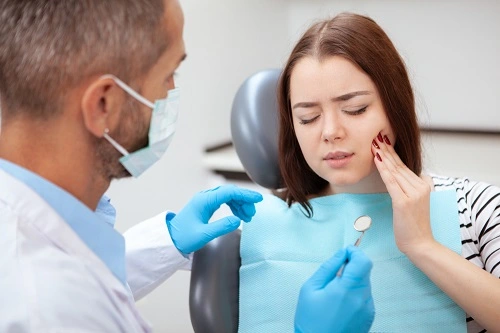A dental emergency can come at any time and should catch you unaware, not leaving you in pain and unsure of the next step. Listening to papers on the basics of emergency dentistry could be the difference between what it takes to be ready for such a situation and total limbo. Below is an all-inclusive guide on most things that we have covered for you in the event of a dental emergency, from a common type of dental emergency to what one needs to do in case there is a dental emergency. This article will get you loaded with knowledge to solve a problem induced by a severe toothache, knocked-out tooth, or any other dental emergency.
What Is Emergency Dentistry?
Emergency dentistry is a dimension of dental care that is the practice area in dental medicine in which special services are used to help patients by treating urgent issues in need of a dentist as soon as possible, maybe from acute toothache to an array of accidents causing a dental injury. Emergency dental care is not a regular session since it is scheduled against sorrow and accidents that cannot wait for a timetable.
Most common types of dental emergencies are:
Toothache
A severe toothache can be incapacitating and could point to something deeper, such as an infection or tooth decay. If particularly painful and the pain does not subside after over-the-counter pain relief, get in touch with an emergency dental care provider.
Knocked-Out Tooth
A knocked-out tooth requires care right away. If you can handle the tooth properly and see a dentist within an hour, it may be possible to reimplant the tooth. To care for a knocked-out tooth, touch it only by the crown (chewing surface). Do not touch the root.
Chipped or Broken Tooth
Pain or aching from a chipped or broken tooth can be chronic. Depending upon the intensity, the issue can indeed be termed an emergency, provided a lot of pain or damage is concerned.
Lost Crown or Filling
Not having a filling or crown can expose the tooth to more damage or even infection. This needs to be replaced or repaired as soon as possible.
Abscessed Tooth
An abscessed tooth is a severe infection where the tooth’s root is infected or in between the gum and tooth. It can be excruciating with swelling and, in some cases, raise a fever. Urgent care is necessary unless you prefer to let the infection take over.
Broken Orthodontics
Broken braces or wires may give you discomfort and also make the situation in your mouth worse. Emergency dental care can assist in repositioning or stabilising the fractures in the constituencies.
Soft Tissue Injuries
Soft tissue injuries of the mouth occur to the gums, lips, or tongue from accidents or trauma. These injuries may develop into profuse bleeding and must be urgently addressed for pain control and management to avoid the onset of an infection.
What to Do in a Dental Emergency:
What you do in a dental emergency can make a big difference in the outcome. Here are some steps to follow for common dental emergencies.
Managing a Severe Toothache
Rinse with warm water to clean. Floss gently to remove any trapped food or debris. Apply a cold compress to the outside of your cheek to reduce swelling. Place aspirin or other painkillers on the aching tooth or the gums; doing so may harm the surrounding gum tissue. Call for emergency dental care.
Handling a Knocked-Out Tooth
Pick the tooth up by its crown and do not touch the root. If the tooth is dirty, rinse it gently with water, but do not scrub it or remove any attached tissue. Push the knocked tooth back in the socket. Keeping the tooth in milk or a solution is recommended. Seek the dentist immediately.
Dealing with a Chipped or Broken Tooth
Rinse the mouth with warm water. Place the broken pieces in a container, if possible. Apply gauze to any area in the mouth that is bleeding for about 10 minutes or until the bleeding stops. Place a cold compress outside your mouth near the chipped or broken tooth to reduce swelling. Make an appointment to visit your dentist as soon as you can.
Addressing a Lost Filling or Crown
Fill the hole with a piece of sugarless gum in case you lose a filling. Replace a crown with dental cement or over-the-counter dental adhesive. Use withers. The tooth involved with the crown should not be chewed on. The dentist should be seen as soon as possible for a replacement
Treatment for an Abscessed Tooth.
Rinse your mouth with lukewarm salt water to help ease the pain and drain pus. Cold compresses should be applied to the outside of the cheek. Over-the-counter pain relievers should be taken. Seek immediate, urgent dental care to contain and reduce the spread of the infection—management of Broken Orthodontics Cover sharp or poking edges with orthodontic wax. Do not chew on hard foods that can cause more trauma. You should schedule an appointment at your orthodontist’s office at the earliest opportunity to have repairs or adjustments made to the appliance.
Management of soft tissue lacerations:
Rinse with warm, saline water. Put a clean cloth or gauze over the bleeding area and press on the wound. They should be followed by applying a cold compress to the area to minimise swelling. If these do not work, bleeding is not controlled, or the lesion is too severe, do not hesitate to get a dental emergency.
How to Prevent a Dental Emergency
Accidents happen, but the following tips can help you avoid the most common dental emergencies.
Tips to Prevent a Dental Emergency:
Maintain good oral hygiene. Brush and floss daily to keep your teeth and gums healthy. Make it a point to visit your dentist for check-ups and cleanings.
Use Protective Gear
Wear a mouthguard for sports to protect your teeth from injury. Also, consider a helmet for biking or in any other case of a head injury risk.
Avoid Hard Foods
Be cautious with hard foods like nuts, ice, and hard candies that can chip or break teeth.
Don’t Use Your Teeth as Tools
Don’t use your teeth as tools. Keep your teeth out of opening packages, biting sick people, or other non-food items.
The Role of Emergency Dentists
The Role of an Emergency Dentist, An emergency dentist is critical in offering on-the-spot care for urgent dental problems. They are trained to deal with a whole lot of different sorts of dental catastrophes. They can best help to relieve pain, prevent further oral complications indirectly resulting from the damage, and help to restore health. Having a reliable emergency dentist or knowing how to contact an urgent dentist can greatly assist.
Selecting an Emergency Dentist
One of the most critical decisions that you will ever have to make is when choosing the right emergency dentist. Here are a few things to look at:
Urgent: Choose a dentist in an urgent clinic or one with extended opening hours to cater to urgent needs.
Location
Find someone who works near your home or place of work so that you do not waste time while travelling in an emergency.
Experience:
Find an emergency dentist in Currambine with expertise in handling several dental emergencies.
Reviews and Recommendations
A good emergency dentist can also be found through reviews on websites posted by former patients and asking friends or family for a recommendation.
Conclusion
Why it is essential to understand emergency dentistry is that it will help someone be up to the task in case of anything that they had not planned for. Learning about common types of dental emergencies, their management, and when to get professional help from a dentist in Currambine would help to a great extent for your oral health. Preparing and taking all precautions to ensure that you will be in an excellent position to know what to do the moment a dental emergency strikes. Remember: If you go to a Currambine dentist as soon as possible, you can preserve your teeth while saving yourself the trouble of experiencing excruciating pain, which will give you a far better long-term result concerning oral health.




